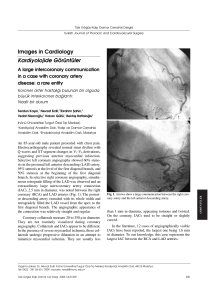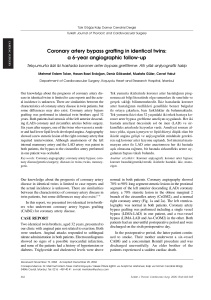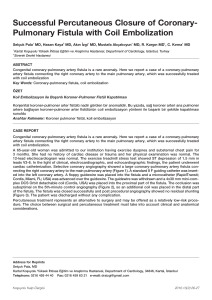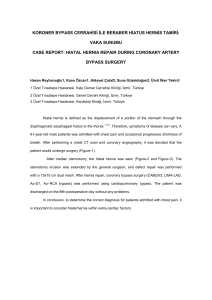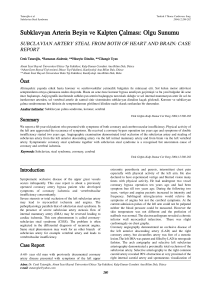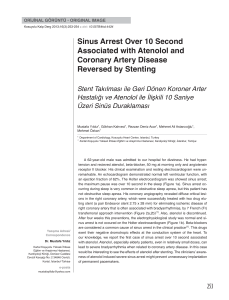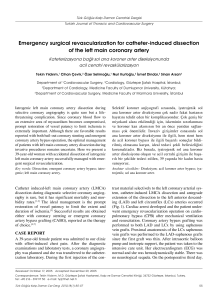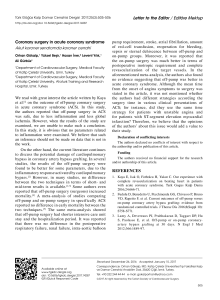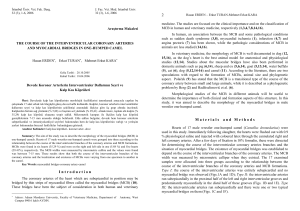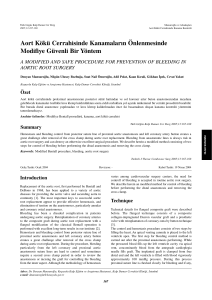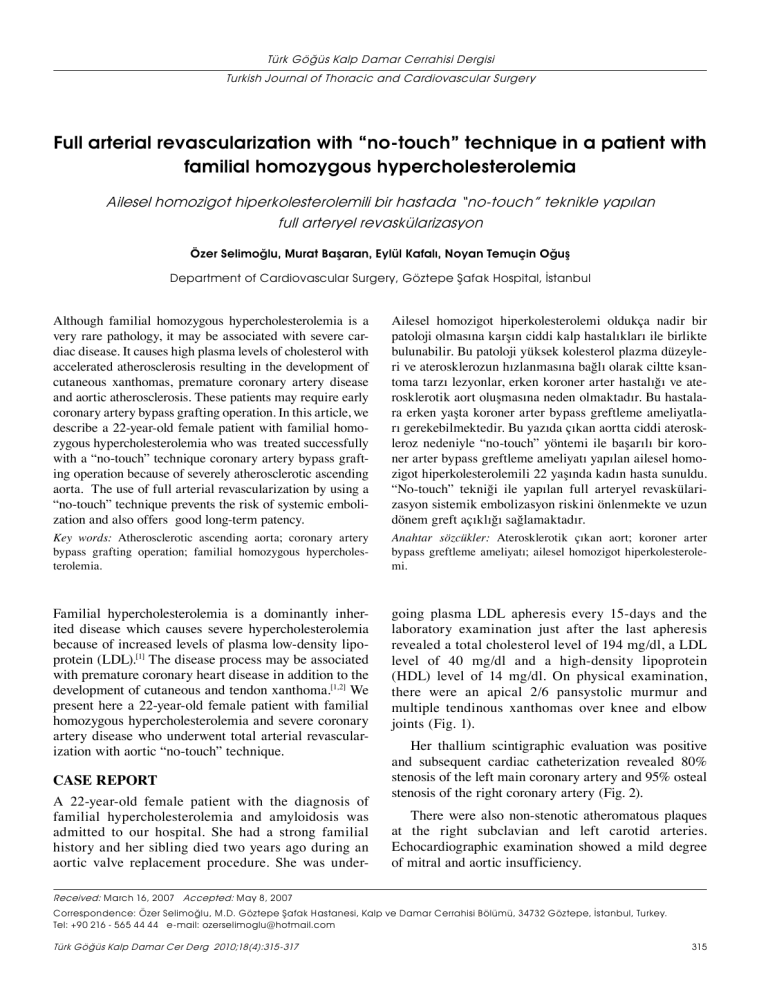
Türk Göğüs Kalp Damar Cerrahisi Dergisi
Turkish Journal of Thoracic and Cardiovascular Surgery
Full arterial revascularization with “no-touch” technique in a patient with
familial homozygous hypercholesterolemia
Ailesel homozigot hiperkolesterolemili bir hastada “no-touch” teknikle yapılan
full arteryel revaskülarizasyon
Özer Selimoğlu, Murat Başaran, Eylül Kafalı, Noyan Temuçin Oğuş
Department of Cardiovascular Surgery, Göztepe Şafak Hospital, İstanbul
Although familial homozygous hypercholesterolemia is a
very rare pathology, it may be associated with severe cardiac disease. It causes high plasma levels of cholesterol with
accelerated atherosclerosis resulting in the development of
cutaneous xanthomas, premature coronary artery disease
and aortic atherosclerosis. These patients may require early
coronary artery bypass grafting operation. In this article, we
describe a 22-year-old female patient with familial homozygous hypercholesterolemia who was treated successfully
with a “no-touch” technique coronary artery bypass grafting operation because of severely atherosclerotic ascending
aorta. The use of full arterial revascularization by using a
“no-touch” technique prevents the risk of systemic embolization and also offers good long-term patency.
Ailesel homozigot hiperkolesterolemi oldukça nadir bir
patoloji olmasına karşın ciddi kalp hastalıkları ile birlikte
bulunabilir. Bu patoloji yüksek kolesterol plazma düzeyleri ve aterosklerozun hızlanmasına bağlı olarak ciltte ksantoma tarzı lezyonlar, erken koroner arter hastalığı ve aterosklerotik aort oluşmasına neden olmaktadır. Bu hastalara erken yaşta koroner arter bypass greftleme ameliyatları gerekebilmektedir. Bu yazıda çıkan aortta ciddi ateroskleroz nedeniyle “no-touch” yöntemi ile başarılı bir koroner arter bypass greftleme ameliyatı yapılan ailesel homozigot hiperkolesterolemili 22 yaşında kadın hasta sunuldu.
“No-touch” tekniği ile yapılan full arteryel revaskülarizasyon sistemik embolizasyon riskini önlenmekte ve uzun
dönem greft açıklığı sağlamaktadır.
Familial hypercholesterolemia is a dominantly inherited disease which causes severe hypercholesterolemia
because of increased levels of plasma low-density lipoprotein (LDL).[1] The disease process may be associated
with premature coronary heart disease in addition to the
development of cutaneous and tendon xanthoma.[1,2] We
present here a 22-year-old female patient with familial
homozygous hypercholesterolemia and severe coronary
artery disease who underwent total arterial revascularization with aortic “no-touch” technique.
going plasma LDL apheresis every 15-days and the
laboratory examination just after the last apheresis
revealed a total cholesterol level of 194 mg/dl, a LDL
level of 40 mg/dl and a high-density lipoprotein
(HDL) level of 14 mg/dl. On physical examination,
there were an apical 2/6 pansystolic murmur and
multiple tendinous xanthomas over knee and elbow
joints (Fig. 1).
Key words: Atherosclerotic ascending aorta; coronary artery
bypass grafting operation; familial homozygous hypercholesterolemia.
CASE REPORT
A 22-year-old female patient with the diagnosis of
familial hypercholesterolemia and amyloidosis was
admitted to our hospital. She had a strong familial
history and her sibling died two years ago during an
aortic valve replacement procedure. She was under-
Anah­tar söz­cük­ler: Aterosklerotik çıkan aort; koroner arter
bypass greftleme ameliyatı; ailesel homozigot hiperkolesterolemi.
Her thallium scintigraphic evaluation was positive
and subsequent cardiac catheterization revealed 80%
stenosis of the left main coronary artery and 95% osteal
stenosis of the right coronary artery (Fig. 2).
There were also non-stenotic atheromatous plaques
at the right subclavian and left carotid arteries.
Echocardiographic examination showed a mild degree
of mitral and aortic insufficiency.
Received: March 16, 2007 Accepted: May 8, 2007
Correspondence: Özer Selimoğlu, M.D. Göztepe Şafak Hastanesi, Kalp ve Damar Cerrahisi Bölümü, 34732 Göztepe, İstanbul, Turkey.
Tel: +90 216 - 565 44 44 e-mail: [email protected]
Türk Göğüs Kalp Damar Cer Derg 2010;18(4):315-317
315
Selimoğlu et al. Full arterial revascularization with “no-touch” technique in a patient with familial homozygous hypercholesterolemia
On the basis of these findings, the patient was taken
up for coronary artery bypass grafting. Following
median sternotomy, gentle digital palpation of the
ascending aorta also revealed circumferential calcification and bulky atheromatous plaque formations.
Transoesophageal echocardiography demonstrated
severe atherosclerotic disease of the ascending aorta
(Fig. 3) and off-pump coronary artery bypass grafting
operation using a “no-touch” technique was decided.
Bilateral internal thoracic arteries and left radial
artery were then harvested, and following systemic
heparinization, the left and right internal thoracic arteries were anastomozed to the left descending and right
coronary arteries respectively by means of 7.0 polypropylene sutures on the beating heart (Estech® cardiac
stabilizators). The left radial artery was then sutured to
the second obtuse marginal artery with the same technique and the proximal anastomosis of the radial artery
graft was placed into the left internal thoracic artery as
a “Y-shaped” anastomosis. After the completion of the
Fig. 1. The patient had multiple tendinous xanthomas over joints.
Fig. 2. Intraoperative view of triple bypass grafting. Left internal
thoracic artery to left anterior descending, right internal thoracic
artery to right coronary artery and radial artery to circumflex obtuse margin 1 artery. Radial artery was anastomozed proximally
to left internal thoracic artery as Y graft.
316
operation, the patient was taken to the intensive care
unit and weaned off mechanical ventilation at the end
of six hours. The postoperative course of the patient
was uneventful and she was discharged on the 7th postoperative day. After the operation, the patient received
antilipidemic therapy (cholestyramine and atorvastatin)
and postoperative control angiography performed on the
6th postoperative month showed patent arterial grafts.
DISCUSSION
Familial homozygous hypercholesterolemia is a rare
pathology which may be associated with early atherosclerotic process affecting all body vessels including the
ascending aorta and carotid arteries. In these patients,
the major challenging issue complicating the intraoperative surgical strategy is the extent and degree of
ascending aortic calcification. Since the manipulation
of such a diseased aorta by aortic cannulation, crossclamping and/or partial clamping may lead to intraoperative embolization, the use of a “ no-touch” off-pump
technique is strongly recommended while dealing with
such patients.[3,4]
The benefits of internal thoracic and radial arteries have been well documented in several studies in
terms of survival and freedom from symptoms.[5-8]
Kawasuji et al.[1] stated that the internal thoracic arteries
of these patients show no histologic differences from
those of patients without familial hypercholesterolemia.
Loop et al.[9] demonstrated that a better cardiac eventfree survival rate may be obtained after internal thoracic
artery grafting to the left anterior descending coronary
artery. In view of these findings, we believe that a good
long-term patency rate can be achieved with arterial
grafts in patients with familial hypercholesterolemia.
Additionally, since our patient was very young at the
time of first operation, a full arterial revascularization
Fig. 3. Transoesophageal echocardiography demonstrated severe
ascending aortic atherosclerosis.
Turkish J Thorac Cardiovasc Surg 2010;18(4):315-317
Selimoğlu ve ark. Ailesel homozigot hiperkolesterolemili bir hastada “no-touch” teknikle yapılan full arteryel revaskülarizasyon
procedure has been considered as the most acceptable
approach to avoid the risk of an early redo operation.
As a conclusion, during a cardiac intervention in
patients with familial hypercholesterolemia, severe atherosclerosis of the ascending aorta, carotid and vertebral
arteries should be also considered. In case of severe
plaque formation, the use of full arterial grafting by
using a “no-touch” technique prevents the risk of systemic embolization and also offers a good long-term patency.
Declaration of conflicting interests
The authors declared no conflicts of interest with respect
to the authorship and/or publication of this article.
Funding
The authors received no financial support for the
research and/or authorship of this article.
REFERENCES
1. Kawasuji M, Sakakibara N, Fujii S, Yasuda T, Watanabe
Y. Coronary artery bypass surgery with arterial grafts in
familial hypercholesterolemia. J Thorac Cardiovasc Surg
2000;119:1008-13.
2. Mabuchi H, Koizumi J, Shimizu M, Takeda R. Development
of coronary heart disease in familial hypercholesterolemia.
Circulation 1989;79:225-32.
Türk Göğüs Kalp Damar Cer Derg 2010;18(4):315-317
3. Suma H. Coronary artery bypass grafting in patients with
calcified ascending aorta: aortic no-touch technique. Ann
Thorac Surg 1989;48:728-30.
4. Buffolo E, de Andrade CS, Branco JN, Teles CA, Aguiar LF,
Gomes WJ. Coronary artery bypass grafting without cardiopulmonary bypass. Ann Thorac Surg 1996;61:63-6.
5. Takahashi T, Nakano S, Shimazaki Y, Kaneko M, Hirata N,
Nakamura T, et al. Long-term appraisal of coronary bypass
operations in familial hypercholesterolemia. Ann Thorac
Surg 1993;56:499-505.
6. Acar C, Ramshey A, Pagny JY, Beyssen B, Fabiani JN,
Deloche A, et al. Five-year results of coronary bypass grafting using the radial artery. 77th Annual Meeting of the
American Association for Thoracic Surgery, May 6, 1997.
Washington, DC; 1997. p. 100-1.
7. Demirkiliç U, Bolcal C, Küçükarslan N, Bingöl H, Oz
BS, Kuralay E, et al. Middle and late-term results of
coronary artery bypass graft surgery in very young (20-29
years) patients. [Article in Turkish] Anadolu Kardiyol Derg
2004;4:25-9.
8. Prapas SN, Anagnostopoulos CE, Kotsis VN, Stavropoulos
GP, Sidiropoulos AV, Ananiadou OG, et al. A new pattern for
using both thoracic arteries to revascularize the entire heart:
the pi-graft. Ann Thorac Surg 2002;73:1990-2.
9. Loop FD, Lytle BW, Cosgrove DM, Stewart RW, Goormastic
M, Williams GW, et al. Influence of the internal-mammaryartery graft on 10-year survival and other cardiac events. N
Engl J Med 1986 2;314:1-6.
317

